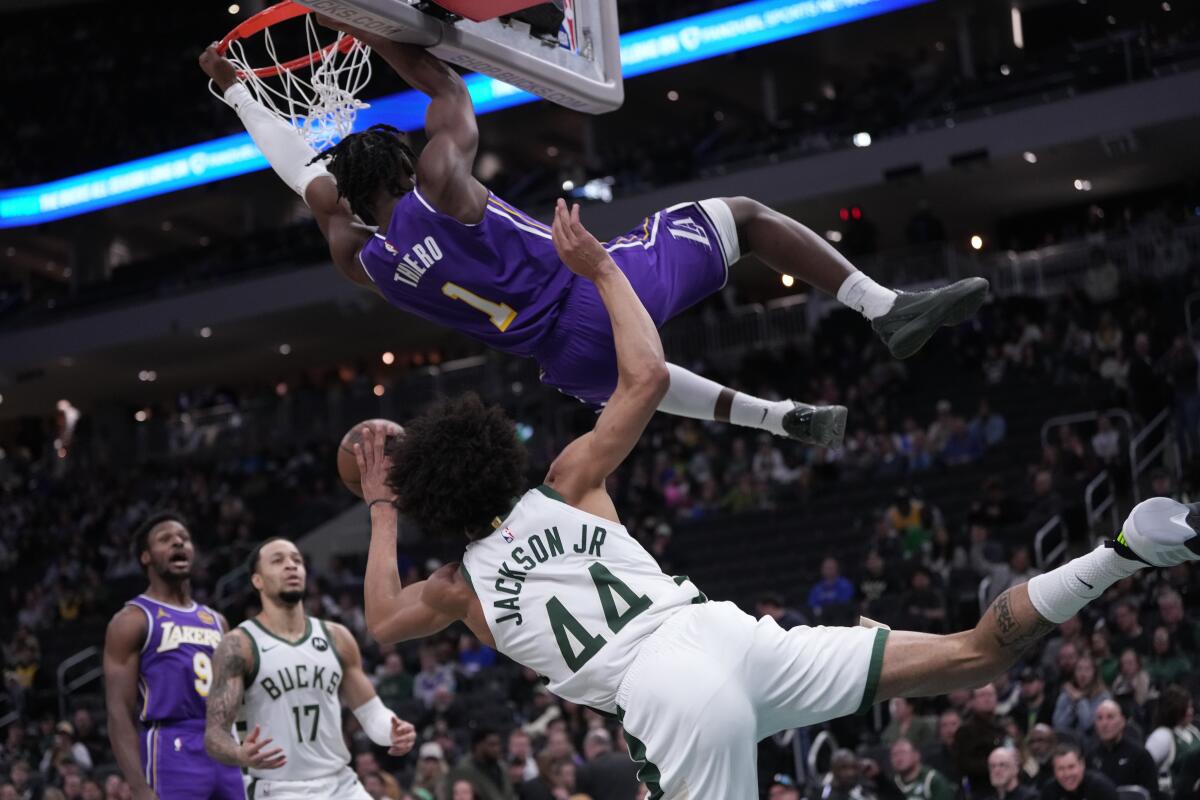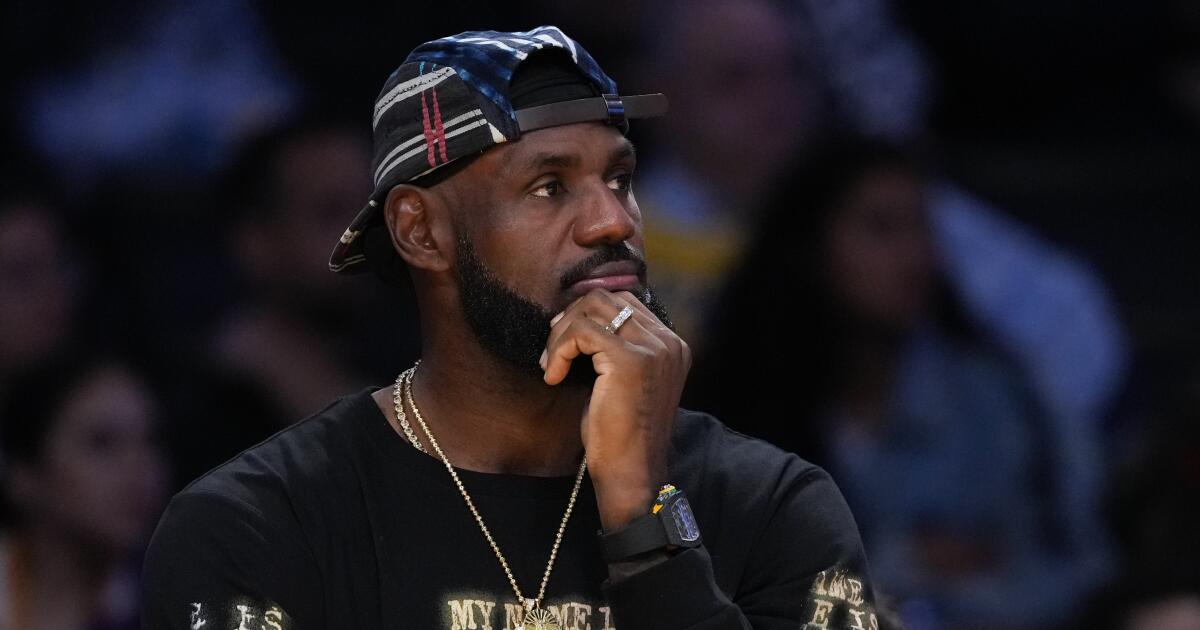Cosm turns ‘Willy Wonka’ into a multisensory experience
We are at the dawn of the era of “experimental cinema.”
At least that is the pitch by entrepreneurs such as Jeb Terry of Cosm and James Dolan of Sphere, whose domed venues have embraced the idea of reviving older films to augment them with new technologies. Terry used the phrase Tuesday in his introduction to a resuscitation of 1971’s “Willy Wonka and the Chocolate Factory,” which debuts this week at Inglewood’s Cosm with modern, CGI animation, aiming to emphasize the whimsy and childlike wonder of the Gene Wilder picture.
“Wonka” is the sophomore attempt by Cosm to redefine the moviegoing experience — “The Matrix” got the Cosm treatment last summer and “Harry Potter and the Sorcerer’s Stone” will follow next year. Seeing a film in what the venue calls “shared reality” can be all-encompassing and yet intimate as well as communal and, if everything works out, somewhat thoughtful. The 87-foot diameter spherical screen wraps above, below and behind us, but an emphasis on couch seating invites a cooperative environment. And guests are encouraged, for instance, to pull out their phones and capture and share the moment.

The spherical screen can give the illusion of dimension.
(Cosm)
It’s good fun, if you don’t take it too seriously, as experiential, in the case of “Wonka,” means a film dedicated to the power of imagination sometimes leaves a little less to it. Spirited and bright, Cosm’s approach to “Wonka,” a collaboration with experiential firm Secret Cinema and visual effects house MakeMake, is to ensure audiences are never not surrounded by eye candy. The result is alternately charming and clashing — why, I wondered, isn’t the animation done in a 1970s style to better complement the film?
In turn, has the film’s new magic replaced its subtle mystery? Or is that the wrong question to ask at screenings meant to feel like a social event, complete with chocolate tarts filled with peanut butter mousse and bright red vodka drinks with gold glitter salt rims?

“Willy Wonka” is the second Hollywood film, following “The Matrix,” to run at Cosm.
(Cosm)
For this is experiential at its most maximal. Opening credits that unfold in the film with streams of chunky chocolate are now accompanied with smoothed-out images that look partly inspired by “Super Mario Bros.,” as tubes and pipes aim to place the audience inside a milky-chocolate-pouring factory. It’s cute, and you’ll find yourself diverting your attention from the framed screen of the film to take in the toy-like animated mechanisms. My only qualm here was the edges of the filmed footage have been sharpened away by gleamingly untroubled animation.
Elsewhere, news reports in the film are elongated to show us an entire, cartoon-like studio, scenes of galloping children on the sidewalk rush by as added assembly lines churn out chocolate below them and the movie’s first major song and dance moment, “The Candy Man,” is now surrounded by carnival-inspired visuals with swirling Candy Buttons, slot-machine-like flowers and gentle prods to, if not sing along, at least mouth the lyrics.
“Wonka,” a moderate success when it was released, grew in stature over time as Sammy Davis Jr. turned “The Candy Man” into a hit and second-run screenings on television made it vital at-home viewing for generations to come. It is, at times, delightfully demented, a family film with a weird streak — perhaps at times even a slightly sinister one. And yet I went to Cosm’s “Wonky” premiere not as a film critic but as someone curious about burgeoning movements in the immersive industry, interested more in how Cosm could use its tech to enhance, revitalize or find ways to illuminate a second-run film.

At Cosm, when Charlie discovers his golden ticket, digital fireworks erupt.
(Cosm)
Illuminate is a key word, as when young Peter Ostrum as Charlie unwraps a candy bar with the much-sought-after golden ticket, the animated images around the framed screen erupted in fireworks. I remember watching that scene as a kid and feeling a bit tense, fearing, perhaps, the ticket would be snatched from him by the crowd that consumes him. Yet Cosm aims to turn “Wonka” into pure joy. Such a moment was a reminder at how much sway over the emotional tonality of the film such supplemental material can possess.
In that sense, the immersive ambitions of Cosm differ from experiments of the past — interactive dalliances in the ’90s that recently lived again on Netflix (see “Black Mirror: Bandersnatch”), or more recent 4DX theaters with movement-enabled seats (see the light, water and wind effects of “Twisters”). Perhaps that’s why what I thought worked best leaned more abstract, when, say, cartoonish cityscapes gave way to black-and-white pencil-like effects, or when the animations played up the wackiness of Wonka’s factory rather than try to flesh it out.

A whimsical scene featuring the Oompa Loompas.
(Cosm)
I was distracted, for instance, when Wilder’s Wonka made his grand limping entrance, as the sheepish building behind him was now dwarfed by sparkly, shiny warehouses. Yet I was transfixed when Wilder’s character near the end was framed amid blindingly fast streaks of light, or when the helper Oompa Loompa characters were depicted out of frame as colorful orbs that looked like strands of DNA.
‘Willy Wonka and the Chocolate Factory’ at Cosm
I do feel it’s important to note that I’m more than two decades removed from having seen the original “Wonka.” Fresher in my mind are more recent cinematic explorations of the material and characters. While I chose to revisit “The Matrix” before taking that film in at Cosm, I opted for a different approach with “Wonka,” and I believe one’s likelihood to embrace what Cosm is attempting will increase exponentially by one’s attachment to the source material. Having forgotten wide swaths of the film, I found myself conflicted — watch the original film, or focus on Cosm’s accouterments — whereas with “The Matrix,” the material was recent on the mind and I was therefore more comfortable to wander and take in the dome’s impressive screen.
And it is impressive, indeed. When Charlie starts floating in Wonka’s factory, Cosm lifts the frame of the film, surrounding it with bubbles. Soon, depending on your seat, you may find yourself looking straight up. Cosm’s visuals are so crisp that at times they can simulate movement and dimension, and we get dizzyingly lost when the characters are trapped in a seemingly doorless room.
Elsewhere, Cosm takes on a buoyancy when Denise Nickerson’s Violet transforms into a bouncy blueberry. Another clever moment: When Charlie’s wall of moving hands is stretched beyond the screen and starts waving to the audience.
It’s in these instances when the film comes alive, and Cosm’s take on experiential cinema no longer feels like a novelty and becomes an experience.

Gene Wilder’s Willy Wonka and Julie Dawn Cole’s Veruca Salt in “Willy Wonka and the Chocolate Factory,” as presented by Cosm.
(Cosm)
















































